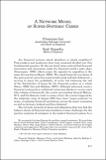| dc.contributor.author | Gai, Prasanna | |
| dc.contributor.author | Kapadia, Sujit | |
| dc.date.accessioned | 2019-11-01T00:05:00Z | |
| dc.date.available | 2019-11-01T00:05:00Z | |
| dc.date.issued | 2010 | |
| dc.identifier.isbn | 978-956-7421-34-3 | |
| dc.identifier.uri | https://hdl.handle.net/20.500.12580/3876 | |
| dc.description | Are financial systems shock absorbers or shock amplifiers? Policymakers and academics have long remained divided over this fundamental question. On the one hand some contend that financial innovation and integration make the financial world a safer place (Greenspan 1999) others argue the opposite by appealing to the same driving forces (Rajan 2005). The rapid financial innovation of the past several years has acted as both good and bad cholesterol— serving to lower the probability of crisis but fattening the tail of the distribution of losses for the financial system as a whole (Gieve 2006 Gai and Haldane 2007). Although advanced country financial systems have withstood numerous shocks in recent years (the collapse of Amaranth the events surrounding General Motors 9/11 and the Dotcom crash to name a few) the events triggered by the subprime crisis of August 2007 have been 'super-systemic' in scope enveloping financial institutions across the major economies as well as faraway Iceland and New Zealand. | |
| dc.format | .pdf | |
| dc.format.extent | Sección o Parte de un Documento | |
| dc.format.medium | p. 411-432 | |
| dc.language.iso | eng | |
| dc.publisher | Banco Central de Chile | |
| dc.relation.ispartof | Series on Central Banking Analysis and Economic Policies no. 15 | |
| dc.rights | Attribution-NonCommercial-NoDerivs 3.0 Chile | * |
| dc.rights.uri | http://creativecommons.org/licenses/by-nc-nd/3.0/cl/ | * |
| dc.subject | CRISIS FINANCIERA | es_ES |
| dc.title | A network model of super-systemic crises | |
| dc.type.doc | Artículo | |
| dc.file.name | BCCh-sbc-v15-p411_432 | |


